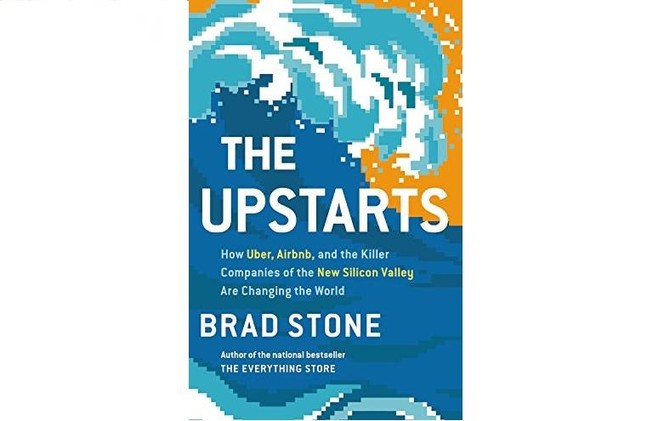The rise of smartphones and social media has enabled the expansion of the sharing economy, a phase during which the likes of Uber and Airbnb were born.
The power of these entrepreneurial ventures is continuously rising. Airbnb has already exceeded 10 million guest stays and Uber continues to grow despite its current failings. No matter how bad the PR is getting for Uber, consumers do not seem to care. As long as the company’s ride hailing app continues to outperform rival apps, Uber will continue to dominate the market.
Brad Stone has covered the Silicon Valley as a journalist for more than fifteen years. After his book “The Everything Store: Jeff Bezos and the Age of Amazon,” which won the Financial Times and Goldman Sachs Business Book of the Year Award in 2013, he is back with an enthralling account of how Uber and Airbnb came to be and how a new generation of entrepreneurs are changing the way we live in “The Upstarts: How Uber, Airbnb, and the Killer Companies of the New Silicon Valley Are Changing the World.”
Travis Kalanick and Brian Chesky, the young CEOs behind Uber and Airbnb respectively, are part of a new breed of tech leaders who are different from the previous generation of introverted innovators such as Bill Gates, Larry Page and Mark Zuckerberg.
“Instead, they are extroverted storytellers, capable of positioning their companies in the context of dramatic progress for humanity and recruiting not only armies of engineers but drivers, hosts, lobbyists and lawmakers to their cause” Stone wrote in the book.
Chesky grew up in Niskayuna, New York, in a middle-class family. Joe Gebbia, who co-founded Airbnb with Chesky, was born in Atlanta, Georgia. The pair met in classes at the Rhode Island School of Design and became firm friends.
After Gebbia graduated, he went to San Francisco and asked Chesky if he would like to come and share the rent of his apartment. Chesky told Gebba that if he made the move, he would keep a new part-time teaching job in Los Angeles but would spend the weekends in San Francisco. For that reason, he asked Gebbia if he could rent the couch in the living room for $500 a month instead of renting a whole room. Gebbia replied that Chesky needed to be fully committed or else he would have to give up the apartment. Just as Chesky decided to make the move, Gebba sent him the e-mail that would change their lives: “I thought of a way to make a few bucks, turning our place into a designer’s bed and breakfast, offering young designers who come into town a place to crash during the four-day event (a design conference), complete with wireless Internet, a small desk place, sleeping mat and breakfast each morning. Ha!”
It took the pair three days to put together the first Airbedandbreakfast.com website using free tools available online. The first guest to use Airbedandbreakfast.com was Amol Surve. He was greeted at the door by the site’s co-creator Gebbia. Surve, who came from Mumbai, had use the Internet to rent an airbed for $80 a night because all the hotels in the area were either booked or too expensive.
He did not know what to expect but soon loved the experience of living in a temporary home. Two other guests also used the apartment during the design conference. After the three travelers left, the co-founders were not only able to pay their rent but they were also touched by the friendships they had made with their guests.
For a year, nothing happened. Chesky and Gebbia looked for investors but “very few people even met with us, they considered us crazy,” Chesky admitted. However, by 2010, Airbnb covered 8,000 cities.
While Chesky and Gebbia were working on better versions of what was still known as Airbedandbreakfast.com, Garret Camp, a Canadian entrepreneur, had just sold a website discovery tool, StumbleUpon, to eBay for $75 million. He was rich and living the good life but he had one problem — his Mercedes-Benz sports car. It stayed in the garage and he barely used it as he found driving in San Francisco to be too stressful. He became obsessed with the idea of an on-demand car service that passengers would be able to track via a map on their phones. He soon found out about the German word “Uber” and settled for the name “UberCab.”
On Nov. 17, 2008, Camp registered UberCab as an LLC in California. In December, on his way to attend LeWeb, a high-profile technology conference in Paris, he stopped in New York to meet Oscar Salazar, a friend. He shared his idea with Salazar who had also experienced problems with cabs in Mexico, Canada and France. “I don’t know if this is a billion-dollar company but it’s definitely a billion-dollar idea,” Salazar said before developing a prototype for Camp.
When UberCab looked for capital, most Silicon Valley investors passed on the deal, just as they had with Airbnb. Eventually, Uber gathered $1.3 million and proceeded to make history.
Uber, unlike Airbnb which had become global as soon as it was launched, had to enter each market on an individual basis. Each city was different and presented unique challenges. One of the greatest problems that Uber faced was the fact that it used contract drivers instead of full-time employees. This triggered endless controversies linked to background checks, proper insurance and the safety of both the drivers and the riders using its service.
By the end of 2016, Uber introduced a new type of work flexibility for its drivers and it also lowered the price of its fares. These measures boosted Uber’s business. In 2014, Uber booked 200 million rides while in 2016, the total number of rides reached one billion and six months later, the number had already doubled.
By the end of 2016, Airbnb and Uber had thousands of employees and offices around the world.
Stone gives us a detailed account of how this new breed of CEO — bold, ruthless and resourceful — is making a lasting impact on the way we live and travel.
Book Review: How Uber and Airbnb are changing the world
Book Review: How Uber and Airbnb are changing the world

What We Are Reading Today: ‘The Evolution of Power’ by Geerat Vermeij

Power has many dimensions, from individual attributes such as strength and speed to the collective advantages of groups.
“The Evolution of Power” takes readers on a breathtaking journey across history and the natural world, revealing how the concept of power unifies a vast range of phenomena in the evolution of life—and how natural selection has placed humanity and the planet itself on a trajectory of ever-increasing power.
What We Are Reading Today: ‘Semi-Detached’

Author: JOHN PLOTZ
When you are half lost in a work of art, what happens to the half left behind? “Semi-Detached” delves into this state of being: what it means to be within and without our social and physical milieu, at once interacting and drifting away, and how it affects our ideas about aesthetics.
The allure of many modern aesthetic experiences, this book argues, is that artworks trigger and provide ways to make sense of this oscillating, in-between place.
What We Are Reading Today: ‘The Ant Collective’

Author: ARMIN SHCIEB
Ants share a vibrant and complex communal life and remarkable abilities to communicate with each other.
“The Ant Collective” presents the world of ants as you have never seen it before, using hyperrealistic, computer-generated imagery that shows 3D-like views of activities inside and outside a thriving nest of red wood ants.
With chapters on topics ranging from the establishment and construction of the nest to the birth of an ant trail and the relocation of a colony, this one-of-a-kind book brilliantly integrates informative descriptions with the illustrations.
What We Are Reading Today: The Shield of Achilles

Author: W. H. Auden Edited by Alan Jacobs
“The Shield of Achilles,” which won the National Book Award in 1956, may well be W. H. Auden’s most important, intricately designed, and unified book of poetry. In addition to its famous title poem, which reimagines Achilles’s shield for the modern age, when war and heroism have changed beyond recognition, the book also includes two sequences—“Bucolics” and “Horae Canonicae”—that Auden believed to be among his most significant work.
Featuring an authoritative text and an introduction and notes by Alan Jacobs, this volume brings Auden’s collection back into print for the first time in decades and offers the only critical edition of the work.
As Jacobs writes in the introduction, Auden’s collection “is the boldest and most intellectually assured work of his career, an achievement that has not been sufficiently acknowledged.” Describing the book’s formal qualities and careful structure, Jacobs shows why The Shield of Achilles should be seen as one of Auden’s most central poetic statements—a richly imaginative, beautifully envisioned account of what it means to live, as human beings do, simultaneously in nature and in history.
Book Review: ‘I Used to Have a Plan: But Life Had Other Ideas’ by Alessandra Olanow

- The author’s storytelling talent and introspective reflections on her personal journey make this book an excellent option for people searching for inspiration and a deeper understanding of life and human experience
“I Used to Have a Plan: But Life Had Other Ideas” is a captivating book by New York-based author Alessandra Olanow. Her book was published in 2020 and talks about a self-discovery journey and resilience.
Through her beautifully crafted stories and storytelling, she takes readers on a journey of self-discovery and invites them to learn through the unexpected experiences that shape their lives.
Through the pages of this book, Olanow shares her personal experiences of how she managed to overcome life’s unpredictable circumstances. With her honesty and interesting narrative, she speaks about the lessons learned on her life journey. From her professional experiences to her personal relationships, Olanow’s story exudes authenticity and reminds the reader that life rarely follows a straight path, which makes life realistic and beautiful at the same time.
One of the strengths of Olanow’s book is her ability to describe the depth of emotions and how she talks about her personal struggles during some of the hardest moments in her life.
She expresses her opinions and reflections on life’s challenges by encouraging the readers to reflect as well on their own journeys, motivating them to overcome their obstacles too.
Moreover, regardless of the ups and downs she encountered, she explained how she maintained a sense of hope and resilience.
Additionally, the book is enriched with evocative descriptions of the places the author has lived and traveled to. Whether she was exploring the busy streets in one city or immersing herself in the serenity of nature, her ability to paint a colorful picture through her words takes readers to these places, allowing them to travel with her in thoughts.
Overall, this book is interesting and inspiring at the same time. It reminds readers of the beauty and resilience of accepting life’s unexpected turns and celebrating the beautiful moments too.
The author’s storytelling talent and introspective reflections on her personal journey make this book an excellent option for people searching for inspiration and a deeper understanding of life and human experience.



















